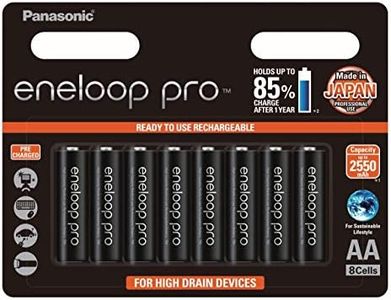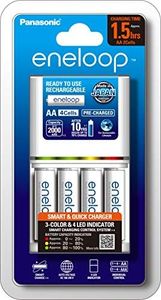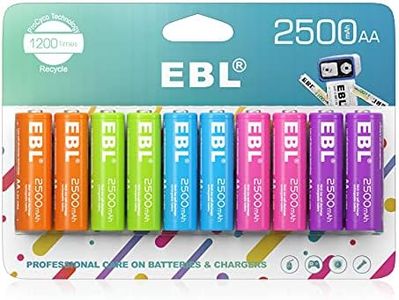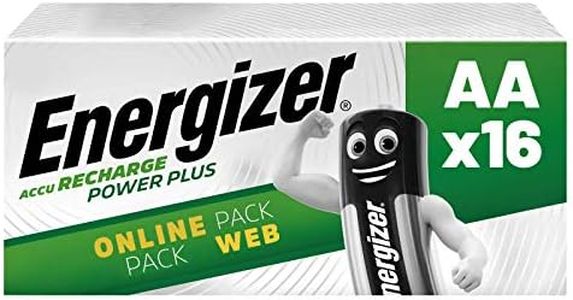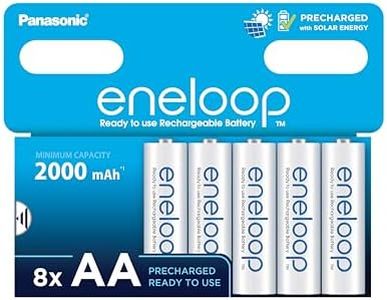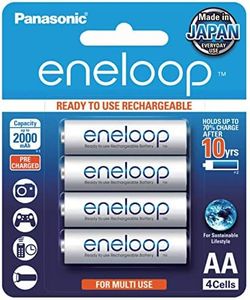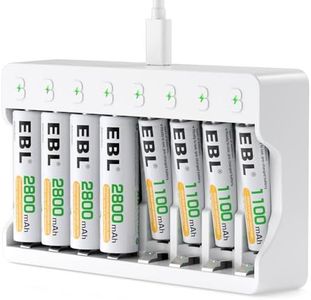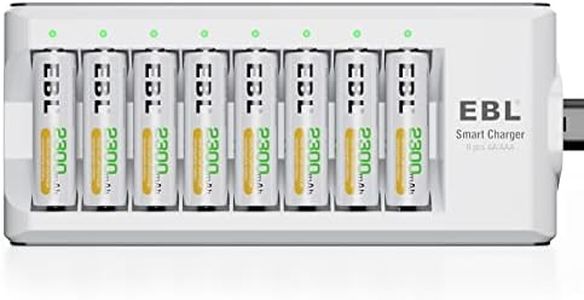We Use CookiesWe use cookies to enhance the security, performance,
functionality and for analytical and promotional activities. By continuing to browse this site you
are agreeing to our privacy policy
10 Best Rechargeable Aa Batteries
From leading brands and best sellers available on the web.Buying Guide for the Best Rechargeable Aa Batteries
When it comes to picking rechargeable AA batteries, your main goal is to find batteries that will deliver enough power for your needs, last a long time between charges, and withstand repeated recharging without quickly losing capacity. Rechargeable AA batteries are popular for devices like cameras, game controllers, toys, remotes, and flashlights. While all AA batteries are physically the same size, their performance, durability, and charging characteristics can vary widely. Understanding a few key specifications will help you match the battery to your intended use and get the best long-term value.Capacity (mAh)Capacity stands for milliamp-hours (mAh) and tells you how much charge the battery can store. The higher the mAh, the longer the battery can power a device before needing to be recharged. Standard rechargeable AA batteries range from around 1300mAh to 2800mAh. Lower capacity (under 1700mAh) works fine for low-power devices like remote controls and clocks. Medium capacity (1700-2200mAh) is good for toys and flashlights. High capacity (above 2200mAh) is best for power-hungry devices like cameras. Consider what you'll use the battery for—if you need your device to run longer between charges, go for a higher mAh value.
Chemistry TypeThe chemistry of a rechargeable AA battery most often refers to NiMH (Nickel Metal Hydride) or, less commonly, older NiCd (Nickel Cadmium). NiMH is the standard today because it is more environmentally friendly and has higher capacity. NiCd, while sometimes available, is less desirable due to its lower capacity and memory effect issues. Some specialty models use newer technologies, but NiMH is the best all-purpose choice for modern users. Unless you have old devices specifically calling for NiCd, choose NiMH for most needs.
Cycle LifeCycle life refers to how many times you can fully charge and discharge the battery before it starts to lose significant capacity. Typical numbers you might see are between 500 and 2000 cycles. A higher cycle life means the battery will last through more uses, which is especially important if you plan to recharge them frequently. For heavy users, batteries with higher cycle life will be more durable, but even a moderate cycle life suits occasional use.
Self-Discharge RateThis specification tells you how much energy the battery loses while just sitting unused. Some rechargeable AA batteries hold their charge for months, while others lose their charge more quickly. 'Low self-discharge' batteries are designed to retain power for longer periods (often 70-85% after a year in storage), making them perfect for emergency devices or things you don’t use daily. If you need batteries for devices that spend lots of time unused such as flashlights or emergency radios, low self-discharge models are best. For daily-use items, self-discharge is less critical.
VoltageMost rechargeable AA batteries provide 1.2 volts, which is slightly less than the 1.5 volts from single-use alkaline AAs. Nearly all devices are designed to work with this minor difference, but some very voltage-sensitive devices may not perform at their best. If you have such equipment, check your manual or product label for voltage advice. For almost all everyday uses, the standard 1.2V is safe and works well.
Charging CompatibilityNot all chargers are made to work with all rechargeable AAs. Most modern chargers cater to NiMH batteries, but older chargers may be for NiCd only or may charge too quickly or too slowly. Make sure you use a charger that matches your battery chemistry and size, and look for smart chargers that automatically stop charging when the battery is full to prolong lifespan. If you plan to recharge often, this feature can prevent damage and improve safety.

